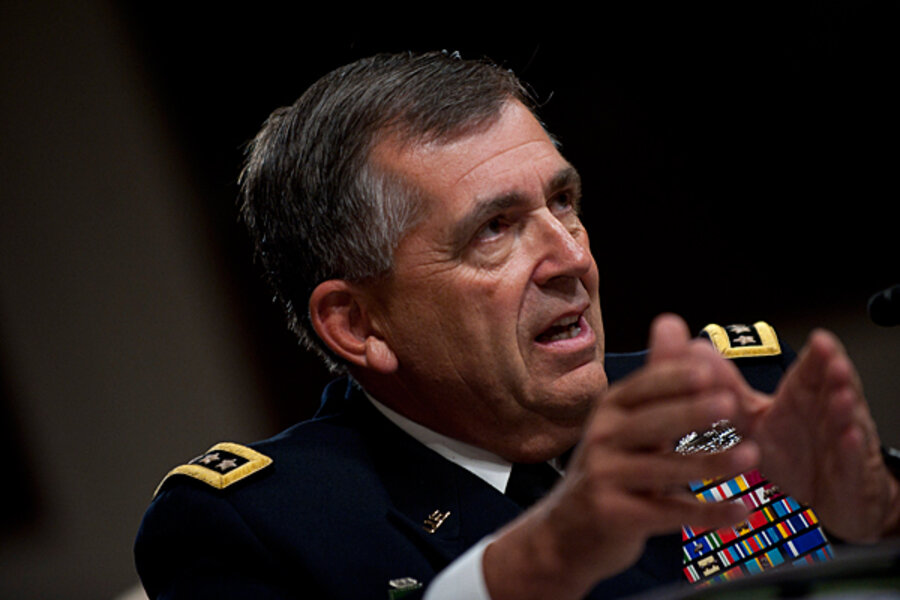Pentagon seeks answers to why suicides doubled in National Guard and Reserve
Loading...
| Washington
There was a glimmer of heartening news out of the Pentagon Wednesday as the military released its most recent analysis of suicide figures, which found a “modest” decrease in suicides among active duty Army troops, from 162 in 2009 to 156 in 2010. It marks the first time in six years that suicides among active-duty soldiers suicides did not increase from the previous year.
But the Pentagon’s latest report also revealed some particularly troubling trends among National Guard and US Army Reserve soldiers: Suicides within their ranks doubled in the past year, from 65 deaths in 2009 to 145 in 2010.
Pentagon officials offered up some suggestions as to why this might be the case. It is often “much more difficult” to get services such as counseling to these soldiers, who are often geographically isolated than their active-duty counterparts and have limited or reduced access to support services, Army Chief of Staff Gen. Peter Chiarelli said.
Meanwhile, with “real world” jobs to hold down in addition to their commitments to the US military, they are “more vulnerable” to the challenges a weak economy. At the same time, they often “lack the ready camaraderie” of soldiers serving on active duty, Chiarelli added in a briefing with reporters Wednesday.
The military “must be even more aggressive” in its efforts to mitigate economic stress on all soldiers – counseling about how not to fall prey to bad loan offers, for example – as well as finding ways to increase resilience and decrease risky behaviors like the use and abuse of prescription drugs, Chiarelli said.
Repeated deployments
Just what role combat plays among soldiers who take their own lives is a question senior military officials continue to debate. Roughly half of National Guard troops who committed suicide last year had never been to combat, according to the Pentagon’s latest figures. “Analysis shows it’s not a deployment problem,” said Gen. Raymond Carpenter, the acting director of the National Guard, who also briefed reporters Wednesday.
Repeated deployments may lead to relationship troubles, however, which do appear to be a striking common denominator among many suicidal troops. More than 50 percent of National Guard members, for example, “had some sort of a partner problem that they were dealing with,” Carpenter said.
The length of soldiers’ dwell time – the military’s term for the period between combat tours for troops – also has an impact “on all kinds of problems,” Chairelli noted.
When soldiers abuse drugs and alcohol in response to combat trauma, for example, those behaviors could certainly lead to “relationship problems,” he added. “The more time we can get between deployments, the better off we’re going to be.”
This assessment is backed by a study also released Wednesday by the RAND Corporation, which concluded, logically enough, that the more tours of combat a soldier serves, the more likely his or her spouse is to report “emotional difficulties” within the family.
Indeed, in its study of suicides, the Army tracked not only deaths among active duty and reserve soldiers, but within their immediate family as well. In 2010, there were a total of 343 suicides by active-duty army and reserve soldiers, Army civilians, and family members.
How to target at-risk families
The research suggests that support be targeted to families facing more months of deployment, “particularly for spouses of National Guard and Reserve members who may not live near military bases where help is more readily available.”
Teaching communication skills to spouses could also be a key to helping improve relationships among soldiers and their spouses – and perhaps reduce the risk that they might sink into risky behaviors.
“We saw that those are critical intervention points – thinking about what we are doing to help families work through the communication challenges,” says Anita Chandra, the RAND study’s lead author and a behavioral scientist.
The US military is also researching the use of virtual technology to help counsel soldiers and pinpoint those that might be at risk of suicide. “We’ve spent a lot of time thinking about how do we use technology for virtual connection? How can we provide support through those mechanisms?” Ms. Chandra says.
The Pentagon has recently done the same, rolling out virtual online support communities – including one that encourages soldiers who have experienced combat stress to use avatars to discuss their anxiety.
Chairelli acknowledged the difficulty of pinpointing any one cause of suicide. “If you think you know the one thing that causes people to commit suicide, please let us know,” he said, “because we don’t.”





